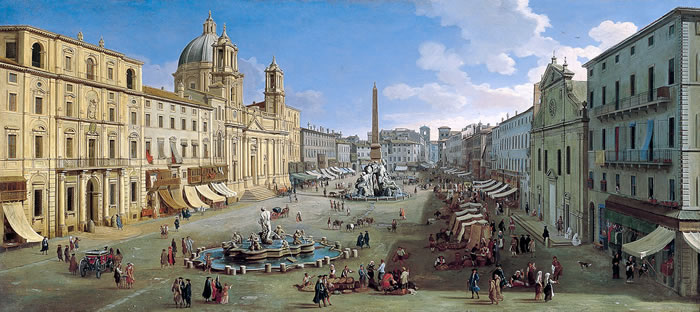Market on Navona Square

In 1500 Piazza Navona was not surrounded by houses but by the gardens of the houses facing the streets that it delimited. The perimeter was marked by the ruins of the Domitian stadium seats; the space was wide and Pope Sixtus IV thought it well to make it the seat of the weekly market of Rome.
The market day was Wednesday and the first was September 3, 1477, it will be maintained, always on Wednesdays, until 1869.
The decision of Pope Sixtus IV was used to solve two problems:
a) Give more space to the market that was held in the Roronda Square in front of the Pantheon that had become too small for the number of sellers who were going to sell their merchandise there;
b) the recovery of the whole area with a tradition that began in the Middle Ages was used only for parties during the Carnival, while the rest of the year was used as a garbage dump.
In Rome, where the Popes had returned from more than a century, it was witnessing a rapid population growth and an increase of travelers who lived there over long periods and this had led to the growth of traffic and trade.
At the end of the fifteenth century in Rome there were three food markets: at Piazza Judea, Piazza della Rotonda and Piazza Celso (present near the Piazza dell'Orologio), while all the other trades were held in Piazza Campo de 'Fiori and the adjacent streets .
The market in Agone was destined to be the new arts market, but before that worked completely it took a few decade; still at the beginning of the sixteenth century there had not been built many homes-workshop how used at the time and those that were built were turning towards the road, while on Campus, so it was called the Square in Agone, there were the backside.
Artisans from all over Italy opened their shops in the new market: two Florentine pottery and a Roman potter, in 1508 a linalool of Bergamo, and then came apothecaries and also sellers of raw materials such as alum, and much more. Market activity was supervising by the Commissioner of Piazza Navona, which expected every year: "Lib. 10 of wax, 3 of peppercorns, 6 pairs of gloves, a box of white"pignolati" (precious cotton fabric).
For the great movement which began, Pope Gregory XIII had put at the center of the square a "drinking trough" for horses that was replaced a century later by one of the most beautiful fountains of Rome: the Fountain of the Four Rivers. For the needs of the houses that were increasing around the square made then build the two fountains that still can be admired: the Fontana del Moro and the Fountain Neptune and both of Giacomo della Porta.
Also in the square they continued to carried out the games during the Carnival; memorable ones in 1500 when over racing and horse races was introduced a triumph eleven triumphal chariots celebrated the victory of Julius Caesar, in a clear allusion to the military victories of Valentino (Cesare Borgia), just back in Rome after the conquest of Forli and the appointment gonfalonier of the Church. In the Renaissance the square was also used for racing, tournaments and carnival games and theater performances ...
Sign up and read the rest of the article!
by M.L. ©ALL RIGHTS RESERVED (Ed 1.0 - 10/10/2016)






